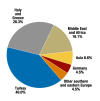Hemoglobinopathies: a longitudinal study over four decades
- PMID: 20186311
- PMCID: PMC2828242
- DOI: 10.3238/arztebl.2010.0065
Hemoglobinopathies: a longitudinal study over four decades
Abstract
Background: Hemoglobinopathies are among the most common hereditary diseases worldwide, with high prevalence in the Mediterranean basin, Africa, and Asia. Although they are rare in the indigenous central European population, they have become much more common in Germany recently through the immigration of millions of people from endemic regions.
Methods: In a long-term study (1971-2007), 100,621 hemoglobin analyses were performed and retrospectively evaluated. Basic clinical and hematological information were provided by the participating physicians. The hemoglobin defects were characterized with hematological and biochemical methods, as well as by DNA analysis in selected cases (from the mid-1980's onward). 73% of the analyses were performed in patients with an immigration background, 27% in patients of German ethnic origin.
Results: 34,228 persons, or 34% of those studied, were found to have a hemoglobinopathy. Most cases involved thalassemia syndromes (25,798 cases, 25.6%); the second most common type was a structural abnormality of hemoglobin (8,430 cases, 8.4%). This study provides the first broad overview of the occurrence, spectrum, and geographical distribution of hemoglobinopathies in Germany.
Conclusions: These data show that hemoglobinopathies are a relevant health problem in the population of Germany today. This is not an epidemiological study, and thus it is unknown to what extent these data are representative. Because hemoglobin defects are of widely diverse genetic and clinical types, specialized laboratory analysis is needed to diagnose them correctly and provide a basis for proper therapeutic decisions.
Figures
Comment in
-
Hemoglobinopathies are on the increase.Dtsch Arztebl Int. 2010 Feb;107(5):63-4. doi: 10.3238/arztebl.2010.0063. Epub 2010 Feb 5. Dtsch Arztebl Int. 2010. PMID: 20186310 Free PMC article. No abstract available.
-
Correspondence (letter to the editor): Equal opportunity.Dtsch Arztebl Int. 2010 Jul;107(27):494. doi: 10.3238/arztebl.2010.0494b. Epub 2010 Jul 9. Dtsch Arztebl Int. 2010. PMID: 20661419 Free PMC article. No abstract available.
-
Correspondence (letter to the editor): HbA1c falsely high or low.Dtsch Arztebl Int. 2010 Jul;107(27):494. doi: 10.3238/arztebl.2010.0494a. Epub 2010 Jul 9. Dtsch Arztebl Int. 2010. PMID: 20661420 Free PMC article. No abstract available.
References
-
- Angastiniotis M, Modell B. Global epidemiology of hemoglobin disorders. Ann NY Acad Sci. 1998;850:251–259. - PubMed
-
- Loukopoulos D, Kollia P. Worldwide distribution of beta-thalassemia. In: Steinberg MH, Forget BG, et al., editors. Disorders of hemoglobin: genetics, pathophysiology and clinical management. Cambridge: University Press; 2001.
-
- Kulozik AE. Hämoglobinopathien. In: Ganten D, Ruckpaul K, editors. Monogen bedingte Erbkrankheiten. Berlin, Heidelberg: Springer-Verlag; 2000. pp. 369–392.
-
- Betke K, Kleihauer E. Hämoglobinanomalien in der deutschen Bevölkerung. Schweiz med Wschr. 1962;92:1316–1319. - PubMed
MeSH terms
LinkOut - more resources
Full Text Sources



